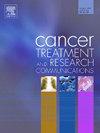福莫那替尼再挑战一线第三代EGFR tki耐药EGFR突变NSCLC:一项回顾性倾向评分匹配队列研究
IF 2.4
Q3 Medicine
引用次数: 0
摘要
背景:克服一线第三代表皮生长因子受体(EGFR)酪氨酸激酶抑制剂(TKIs)对非小细胞肺癌(NSCLC)的耐药性仍然是一个挑战。本研究旨在比较在这种情况下,福莫那替尼再挑战和化疗的有效性。方法:纳入一线第三代EGFR TKIs进展后接受呋莫那替尼或化疗的非小细胞肺癌患者。特征通过多变量logistic回归模型进行倾向评分匹配。未配对组采用卡方检验,配对组采用McNemar检验,比较两组患者的客观缓解率(ORR)和疾病控制率(DCR)。绘制无进展生存期(PFS)和总生存期(OS)的Kaplan-Meier曲线。采用Cox比例风险模型计算PFS的风险比(HR)。结果:共纳入97例患者(福莫那替尼组31例,化疗组66例),配对28对。大多数特征都很平衡。在未匹配的患者中,两组的ORR和DCR相似(均P < 0.05)。中位PFS分别为8.6和8.5个月(HR 1.02 [95% CI 0.60-1.74]; P = 0.948)。中位OS未达到,为32.0个月。在匹配的患者中,ORR和DCR也具有可比性(均P < 0.05)。furmonertinib组的中位PFS在数值上长于化疗组(8.6个月vs 5.7个月;HR 0.67 [95% CI 0.35-1.28]; P = 0.223)。未达到中位OS。与化疗相比,呋门那替尼也具有更好的安全性。结论:与化疗相比,Furmonertinib对一线第三代EGFR TKIs耐药的NSCLC患者具有相似的疗效和更好的安全性。匹配后,福莫那替尼的PFS数值上比化疗更长。随机对照试验是有必要的。本文章由计算机程序翻译,如有差异,请以英文原文为准。
Furmonertinib rechallenge for first-line third-generation EGFR TKI-resistant EGFR-mutant NSCLC: A retrospective propensity score-matched cohort study
Background
Overcoming resistance of first-line third-generation epidermal growth factor receptor (EGFR) tyrosine kinase inhibitors (TKIs) for non-small cell lung cancer (NSCLC) remained a challenge. This study aimed to compare the effectiveness of furmonertinib rechallenge and chemotherapy in this setting.
Methods
NSCLC patients receiving furmonertinib or chemotherapy after progression on first-line third-generation EGFR TKIs were included. Characteristics were used for propensity score matching through a multivariable logistic regression model. Objective response rates (ORR) and disease control rates (DCR) were compared using chi-squared test between the two groups in unmatched patients and McNemar test in matched patients. Kaplan-Meier curves of progression-free survival (PFS) and overall survival (OS) were plotted. Hazard ratios (HR) for PFS were calculated using Cox proportional hazards models.
Results
Totally 97 patients were included (31 in the furmonertinib group and 66 in the chemotherapy group), and 28 pairs were matched. Most characteristics were well-balanced. In unmatched patients, ORR and DCR were similar in the two groups (both P > 0.05). Median PFS were 8.6 and 8.5 months (HR 1.02 [95% CI 0.60–1.74]; P = 0.948). Median OS were not reached and 32.0 months. In matched patients, ORR and DCR were also comparable (both P > 0.05). Median PFS for furmonertinib was numerically longer than that for chemotherapy (8.6 months vs 5.7 months; HR 0.67 [95% CI 0.35–1.28]; P = 0.223). Median OS were not reached. Furmonertinib also had superior safety profiles compared with chemotherapy.
Conclusions
Furmonertinib showed similar effectiveness and better safety compared with chemotherapy in NSCLC patients resistant to first-line third-generation EGFR TKIs. After matching, furmonertinib demonstrated numerically longer PFS than chemotherapy. Randomized controlled trials are warranted.
求助全文
通过发布文献求助,成功后即可免费获取论文全文。
去求助
来源期刊

Cancer treatment and research communications
Medicine-Oncology
CiteScore
4.30
自引率
0.00%
发文量
148
审稿时长
56 days
期刊介绍:
Cancer Treatment and Research Communications is an international peer-reviewed publication dedicated to providing comprehensive basic, translational, and clinical oncology research. The journal is devoted to articles on detection, diagnosis, prevention, policy, and treatment of cancer and provides a global forum for the nurturing and development of future generations of oncology scientists. Cancer Treatment and Research Communications publishes comprehensive reviews and original studies describing various aspects of basic through clinical research of all tumor types. The journal also accepts clinical studies in oncology, with an emphasis on prospective early phase clinical trials. Specific areas of interest include basic, translational, and clinical research and mechanistic approaches; cancer biology; molecular carcinogenesis; genetics and genomics; stem cell and developmental biology; immunology; molecular and cellular oncology; systems biology; drug sensitivity and resistance; gene and antisense therapy; pathology, markers, and prognostic indicators; chemoprevention strategies; multimodality therapy; cancer policy; and integration of various approaches. Our mission is to be the premier source of relevant information through promoting excellence in research and facilitating the timely translation of that science to health care and clinical practice.
 求助内容:
求助内容: 应助结果提醒方式:
应助结果提醒方式:


